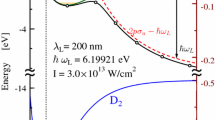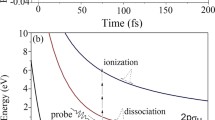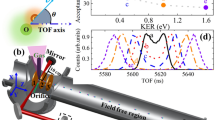Abstract
In this study it has been carried out theoretical simulations of ab-initio molecular dynamics of the C–H photo-dissociation of methane induced by femtosecond laser pulses. Our discussion about the reaction mechanism leading to the formation of the H and \(\hbox {CH}_{3}\) fragments is based on the rectification of the Lorentz force. Such an electric force rectification occurs via a periodical charge transfer between H and \(\hbox {CH}_{3}\) induced by the strong infrared laser pulse.
Similar content being viewed by others
Avoid common mistakes on your manuscript.
1 Introduction
The conversion of methane to value-added chemical products such as alcohols, aldehydes and higher alkanes is one of the greatest challenges of these last years [1–4]. Methane is the most inert of hydrocarbons and the principal constituent of the natural gas [1, 2]. The large amount of the worldwide reserves of natural gas and the difficulty associated with its transportation have prompted a great deal of the researches in order to convert the methane gas to liquid chemical products [4–11]. Development of the new catalysts with high performance in activating of the methane C–H bond has been the main interest of the majority of the experimental and theoretical studies[4–9, 12–17]. Nevertheless, it has been verified that the vibrational excitation of methane can play an important role in activating of this inert molecule [18–27]. In this last years, significant progress has been made toward understanding of the role of vibrations in the chemical reactions with methane [18–26].
In gas phase and gas surface, studies employing laser-based techniques have been shown that it is possible to prepare well-defined vibrational eigenstates so that the methane activation follows a specific reaction pathway along the excited vibrational mode [23, 25, 26]. In the studied reactions, the methane vibrational excitation has shown to be highly mode selective, i.e., the mode of internal excitation controls the reaction outcomes. Moreover, the localization of the vibrational energy remains in the excited mode until the activation reaction completely takes place.
The interest of promoting infrared (IR) excitation in resonance with a selected vibrational and the rapid advances in the technology of femtosecond pulsed laser have stimulated an increasing number of studies about the fragmentation of methane induced by ultra-short laser pulses [28–32]. The efficiency of using femtosecond laser pulses to guide and follow the nuclear motion, breaking or forming selected bonds during a chemical reaction has been studied for many years [33, 34]. With the interaction of high intensity (\({\sim }10^{12} {-} 10^{14} \hbox { W}/\hbox {cm}^2\)) femtosecond laser pulses, molecules can undergo a variety of dynamical processes, in which neutral fragmentation can occur [31, 32]. The neutral dissociation of methane is thus explained as multiple channel dissociation of the super-excited states of the parent molecule [31, 32].
In the present work, we investigate theoretically, through ab-initio molecular dynamics simulations calculations, the chemical reaction of dissociation of methane induced by intense femtosecond IR pulses. An alternative mechanism based on the rectification of the electric force [35] is employed to explain the neutral fragmentation of C–H bond in methane. A strong IR laser field induces a periodical charge transfer between different parts of the molecule, resulting in the rectification of the Lorentz force. This creates the opportunity to produce a direct mechanical action of the light on atoms or group of atoms in the molecule.
2 Methodology
2.1 General
To describe the photo-induced dynamics, we employ a scheme based on ab-initio MD simulations, which has been used to predict, from first principles, structural and dynamical properties of molecules. In our theoretical treatment, the nuclear dynamics is described classically by the equation of motion based on forces derived from self-consistent density functional theory (DFT) [36] calculations, also including in the Hamiltonian an additional term corresponding to the interaction between an external laser field and the electrons and nuclei of the molecular system,
Here, \(H_0\) is the time independent electronic Hamiltonian and V(t) contains the interaction between the molecule and the time-dependent laser field \(\mathbf{E}(t)\) in accordance with the expression
In Eq. (2), \(Z_I\) is the atomic number of the Ith nucleus and \(\mathbf{R}_I\) and \(\mathbf{r}_i\) are the coordinates of the Ith nucleus and ith electron, respectively. The electric field \(\mathbf{E}(t)\) of the electromagnetic radiation is given by
where \(\mathbf{e}\) is the polarization vector of the light, c is the speed of light, \(\varepsilon _0\) is the permittivity and I(t) describes the temporal shape of the laser pulse which is modulated in the calculations by a Gaussian
Here \(I_0\) is the peak intensity of radiation, \(\tau\) is the half width at half maximum (HWHM), interpreted as the laser pulse duration, and \(t_0\) is the peak position of the laser pulse.
Finally, the Lorentz force \(\mathbf{F}_{e}(t)\) acting on each atom or group of atoms is defined as the product of the strength of the electric field and charge q(t) on the respective atom or group of atoms [35]
2.2 DFT and computational aspects
All calculations and simulations have been performed on the framework of Kohn–Sham density functional theory (DFT) [36] using the exchange-correlation functional generalized treated within the gradient approximation of Perdew–Burke–Ernzerhof (GGA-PBE) [37] and norm-conserving pseudopotentials [38] as implemented in the SIESTA program [39]. This program has been previously modified with the inclusion of the temporal dependence of the external electric field [40]. The solutions of the Kohn–Sham equations are expanded as a linear combination of atomic orbitals (LCAO) of finite range. We use a double-zeta basis set plus polarization orbitals. The ab-initio level of the MD method is crucial in our simulation due to the large sensitivity of the nuclear dynamics to the electronic polarization by the laser field. In the molecular dynamics simulations, the Verlet algorithm has been used for integrating the equations of motions for each time step of 0.2 fs during a time interval of 3 ps. The initial temperature of the molecular dynamics simulations is 300 K. We have taken care that the maximum number of the self-consistent field (SCF) interactions used in our simulations has been sufficient to the complete convergence of the density matrix in each time step of the molecular dynamics.
2.3 The laser pulse
The femtosecond laser pulse is modulated by a Gaussian function with the following parameters: duration \(\tau =40 \hbox { fs}\), intensity \(I_0=2.9\times 10^{14} \hbox { W}/\hbox {cm}^2\) and frequency \(\omega = 0.154 \hbox { eV}\) (in units of \(\hbar \omega\), which we will use henceforth). The intensity of \(I_0=2.9\times 10^{14} \hbox { W}/\hbox {cm}^2\) corresponds to the electric field of strength of 4.67 V/Å. Once the aim of this study is to increase the reactivity of the methane molecule, we have assumed for the IR field frequency to be nearly in resonance with the triply degenerate C-H bending vibrations (\(3 \nu _{4}\)), \(\omega \approx \omega _\mathrm{bending}\). The femtosecond laser pulse is modulated by a Gaussian function centered at the time \(t_0 =320 \hbox { fs}\). The phase \(\varphi = 0\) has been used to obtain the maximum intensity (\(I_0\)) of the few-cycle IR pulse at the instant \(t_0= 320 \hbox { fs}\) (see Fig. 1a). The initial orientation of the molecular system relative to the polarization vector (e) of the electromagnetic radiation is such that the polarization vector of the electromagnetic radiation is parallel to the \(\hbox {C}_{2}\) axis of symmetry of methane (see Fig. 2 at \(t =0\)).
a Time dependence of electric field \(\mathbf{E}(t)\) [Eq. (3)] for the molecular dynamics of methane shown in Fig. 2. The parameters of the laser pulse are \(\omega = 0.154\,\hbox {eV}, \tau = 40 \hbox { fs},\) \(I_0 =2.9 \times 10^{14} \hbox { W}/\hbox {cm}^2\) and \(t_0 = 320 \hbox { fs}\). b, c show, respectively, the temporal evolution of the total dipole moment (\(\upmu\)) and the total energy of the molecular system. The time dependence of the C–H bond in methane is shown in d
3 Results and discussion
The aim of this study is to investigate, through ab-initio molecular dynamics simulations, the C–H dissociation in methane induced by femtosecond laser pulses. The trajectory of the atomic nuclei during the molecular dynamics simulations depends strongly on the starting point of the molecular structure, which is, in general, obtained from the equilibrium geometry of the molecule. Thus, the molecular structure of methane was previously optimized which shows a tetrahedral geometry (\(\angle \hbox {H}{-}\hbox {C}{-}\hbox {H} = 109.5^{\circ }\)) with the CH bond distance of 1.14 Å. These parameters are in agreement with the experimental values available in the literature [41].
Because \(\hbox {CH}_4\) is a very inert molecule, with a C–H bond dissociation energy of 4.55 eV [42], a careful selection of the laser pulse parameters becomes a crucial step to succeed in promoting the methane fragmentation. Some important parameters are the high intensity (\({\sim } 10^{13}{-}10^{14}\)) of the IR laser source, which generates strong variable electric fields with the frequency in nearly resonance with some of the vibrational normal modes of the molecule [in this study, the triply degenerate C–H bending vibrations (\(3 \nu _{4}\))]. Another important parameter which must be related to the laser frequency choice is the initial orientation of the molecular system relative to the polarization vector (e) of the electromagnetic radiation. In our simulations, the polarization vector of the electromagnetic radiation is oriented along the \(\hbox {C}_{2}\) axis of symmetry of methane (see Fig. 2 at \(t =0\)). The interaction of the laser pulse in which the temporal evolution of the electric field is shown in Fig. 1a with methane polarizes the molecule creating a large induced dipole moment (\(\upmu\)), see Fig. 1b. The time dependence of \(\upmu\) follows the temporal oscillation of the electric field. After the end of the laser interaction, the dipole moment of the molecular system becomes different from zero what is an indicative of the occurrence of a chemical reaction where the products are polar molecular fragments.
The interaction of the molecular system with the radiation source allows the molecule to absorb energy. The time dependence of the total energy of the molecule is shown in Fig. 1c. The total energy oscillates during the time interval of interaction of radiation with molecule, and it becomes constant after the end of the pulse. From Fig. 1c, it can be seen that the molecule absorbs an amount of energy of 7.85 eV from the light, which is more than enough to lead the C–H dissociation in methane. As we have demonstrated previously [40], the absorbed energy cannot be understood as the only determinant factor to induce the molecular reaction. This together with the proper choice of the laser pulse parameters constitute fundamental conditions to lead to a desired molecular dynamics. From Fig. 1d one can see that, in our simulations, both conditions are satisfied. Fig. 1d shows the time dependence of the C–H interatomic distance in methane. It is observed that the C–H distance starts fast grow even during the laser interaction, and after the time \(t=360 \hbox { fs}\) the C–H bond is broken. The light-induced ab-initio molecular dynamics of methane is presented in Fig. 2. We observe that the dissociation of methane occurs at around \(t= 362 \hbox { fs}\) and the \(\hbox {CH}_{3}\) fragment evolves from a trigonal pyramid geometry just after the C–H dissociation to the planar geometry of methyl at the instant after \(t= 430 \hbox { fs}\).
Light-induced molecular dynamics of methane. The polarization vector of the light is parallel to the \(\hbox {C}_{2}\) axis of symmetry of methane. The parameters of the laser pulse are \(\omega = 0.154 \hbox { eV}, \tau =40 \hbox { fs}, I_0 = 2.9 \times 10^{14} \hbox { W}/\hbox {cm}^2\) and \(t_0 = 320 \hbox { fs}\)
To explain the photoinduced C–H dissociation of methane, we base our discussion on a mechanism proposed previously [35] about the mechanical action of the IR light on atoms or group of atoms based on the rectification of the Lorentz force. Figure 3 presents the rectification of the Lorentz force E(t)q(t) acting on the hydrogen and methyl fragments of methane. Figure 3a shows the temporal dependence of the electric field of the electromagnetic radiation. When applying a high intensity oscillating IR field, it induces a periodic charge transfer between the hydrogen and methyl groups which is presented in Fig. 3b, c with charges obtained form the Mulliken population analysis. When the product E(t)q(t) is calculated, we observe clearly the rectification effect of the Lorentz force acting on H and \(\hbox {CH}_{3}\), see Fig. 3b, c, respectively. During the light—molecule interaction, the Lorentz force starts to act on hydrogen and methyl groups in opposite directions moving than apart each other. This mechanical action results in the fragmentation of methane at around \(t= 360 \hbox { fs}\), as it was discussed above. It can be concluded the hydrogen and methyl move like in a permanent electric field once the light-induced charge follows adiabatically the oscillations of the electric field. Thus, the rectified force which starts immediately with the appearance of the pulse leading to a fast methane fragmentation.
Time evolution of the electric field \(\mathbf{E}(t)\) is shown in a. The parameters of the laser pulse are \(\omega = 0.154 \hbox { eV}, \tau =40 \hbox { fs}, I_0 = 2.9 \times 10^{14} \hbox { W}/\hbox {cm}^2\) and \(t_0 =320 \hbox { fs}\). b, c show the rectification of the Lorentz forces E(t)q(t) acting, respectively, on the H and \(\hbox {CH}_3\) atomic groups of methane which results in a fast fragmentation of C–H bond. The temporal evolution of the net charges (Mulliken) are also displayed in b, c, respectively, for the H and \(\hbox {CH}_3\) fragments
4 Summary
In summary, we presented quantum molecular dynamics simulations of the methane fragmentation induced by strong femtosecond laser pulses. We explain the C–H dissociation in methane via a mechanism based on the rectification of the Lorentz force. The variable electric field induces a synchronous charge transfer that leads to the rectification of the electric force acting on the H and \(\hbox {CH}_{3}\) molecular fragments.
References
J.R. Rostrup-Nielsen, Catal. Today 63, 159 (2000)
J.H. Lunsford, Catal. Today 63, 165 (2000)
T.V. Choudhary, E. Aksoylu, D.W. Goodman, Catal. Rev. 45, 151 (2003)
V. Degirmenci, D. Uner, A. Yilmaz, Catal. Today 106, 252 (2005)
B. Michalkiewicz, Appl. Catal. A Gen. 307, 270 (2006)
L. Chen, B. Yang, X. Zhang, W. Dong, K. Cao, X.P. Zhang, Energy Fuels 20, 915 (2006)
W. Dai, H. Yu, Q. Chen, Y.X. Yin, X.Y. Dai, Plasma Sci. Technol. 7, 3132 (2005)
J.A. Labinger, J.E. Bercaw, Nature 417, 507 (2002)
R.L. Lieberman, A.C. Rosenzweig, Nature 434, 177 (2002)
J.K. Perry, G. Ohanessian, W.A. Goddard III, Organometallics 13, 1870 (1994)
R.A. Periana, D.J. Taube, S. Gamble, H. Taube, T. Satoh, H. Fujii, Science 280, 560 (1998)
M. Svensson, P.E.M. Siegbahn, M.R.A. Blomberg, J. Phys. Chem. 95, 4313 (1991)
M. Svensson, P.E.M. Siegbahn, M.R.A. Blomberg, J. Am. Chem. Soc. 114, 6095 (1992)
M. Svensson, P.E.M. Siegbahn, M.R.A. Blomberg, J. Phys. Chem. 98, 2062 (1994)
A.M.C. Wittborn, M. Costas, M.R.A. Blomberg, P.E.M. Siegbahn, J. Phys. Chem. 107, 4318 (1997)
R.H. Crabtree, Chem. Rev. 95, 987 (1995)
K.J. de Almeida, A. Cesar, Organometallics 25, 3407 (2006)
W.R. Simpson, A.J. Orr-Ewing, R.N. Zare, Chem. Phys. Lett. 212, 163 (1993)
W.R. Simpson, T.P. Rakitzis, A.J. Orr-Ewing, S.A. Kandel, R.N. Zare, J. Chem. Phys. 103, 7313 (1995)
W.R. Simpson, T.P. Rakitzis, S.A. Kandel, T. Levon, R.N. Zare, J. Chem. Phys. 100, 7938 (1996)
A.J. Orr-Ewing, W.R. Simpson, T.P. Rakitzis, S.A. Kandel, R.N. Zare, J. Chem. Phys. 106, 5961 (1997)
S.A. Kandel, R.N. Zare, J. Chem. Phys. 109, 9719 (1998)
Z.H. Kim, H.A. Bechtel, R.N. Zare, J. Am. Chem. Soc. 123, 12714 (2001)
L.B.F. Juurlink, P.R. Mccabe, R.R. Smith, C.L. Dicologero, A.L. Utz, Phys. Rev. Lett. 83, 868 (1999)
M.P. Schmid, P. Maroni, R.D. Beck, T.R. Rizzo, J. Chem. Phys. 117, 8603 (2002)
R.D. Beck, P. Maroni, D.C. Papageorgopoulos, T.T. Dang, M.P. Schmid, T.R. Rizzo, Science 302, 98 (2003)
R.R. Smith, D.R. Killelea, D.F. DelSesto, A.L. Utz, Science 304, 992 (2004)
S. Wang, X. Tang, L. Gao, M.E. Elshakre, F. Kong, J. Chem. Phys. A 107, 6123 (2003)
Z. Wu, C. Wu, Q. Liang, S. Wang, M. Liu, Y. Deng, Q. Gong, J. Chem. Phys. 126, 074311 (2007)
E. Irani, R. Sadighi-Bonabi, A. Anvari, Chem. Phys. Lett. 604, 60 (2014)
S. Koseki, N. Shimakura, Y. Teranishi, S.H. Lin, Y. Fujimura, J. Phys. Chem. A 117, 333 (2013)
H. Xu, A. Azarm, S.L. Chin, Chin. Opt. Lett. 12, 113201 (2014)
A.H. Zewail, J. Phys. Chem. A 104, 5660 (2000)
V.C. Felicíssimo, F.F. Guimarães, F. Gel’mukhanov, A. Cesar, H. Ågren, J. Chem. Phys. 122, 094319 (2005)
Y. Tu, V.C. Felicíssimo, F.F. Guimarães, H. Ågren, F. Gel’mukhanov, Phys. Scr. 80, 055801 (2009)
R.G. Parr, W. Yang, Density-Functional Theory of Atoms and Molecules (Oxford University Press, New York, 1989)
J.P. Perdew, K. Burke, M. Ernzerhof, Phys. Rev. Lett. 77, 3865 (1996)
N. Troullier, J.L. Martins, Phys. Rev. B 43, 1993 (1991)
J.M. Soler, E. Artacho, J.D. Gale, A. García, J. Junquera, P. Ordejón, D. Sánchez-Portal, J. Phys. Condens. Matter 14, 2745 (2002)
V.C. Felicíssimo, J. da Rocha Martins, I.S. Boldt, H. Chacham, Phys. Rev. A 80, 063410 (2009)
D.L. Gray, A.G. Robiette, Mol. Phys. 37, 1901 (1979)
B. Ruscic, M. Litorja, R.L. Asher, J. Phys. Chem. A 103, 8625 (1999)
Acknowledgments
This work was supported by the Brazilian agencies FAPITEC/SE (Fundação de Apoio à Pesquisa e à Inovação Tecnológica do Estado de Sergipe) and CAPES (Coordenação de Aperfeiçoamento de Pessoal de Nível Superior).
Author information
Authors and Affiliations
Corresponding author
Rights and permissions
About this article
Cite this article
Santana, A.J., da Silva, D.A., Machado, E.S. et al. Fragmentation dynamics of methane induced by femtosecond laser pulses. Appl. Phys. B 122, 28 (2016). https://doi.org/10.1007/s00340-015-6303-x
Received:
Accepted:
Published:
DOI: https://doi.org/10.1007/s00340-015-6303-x







